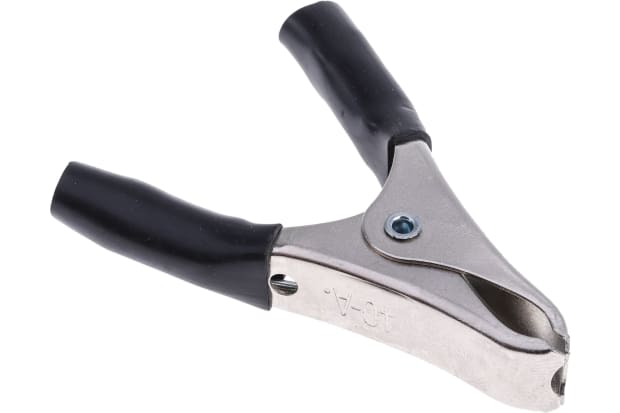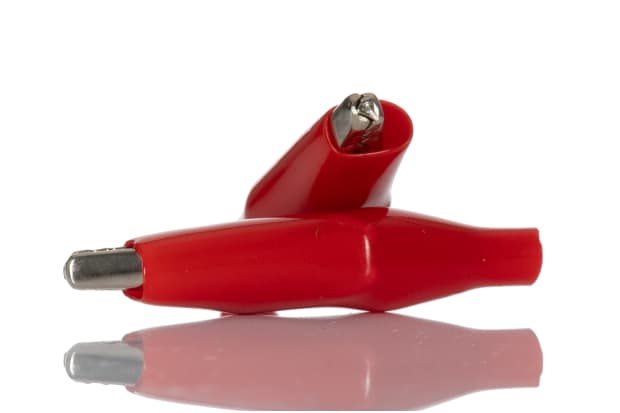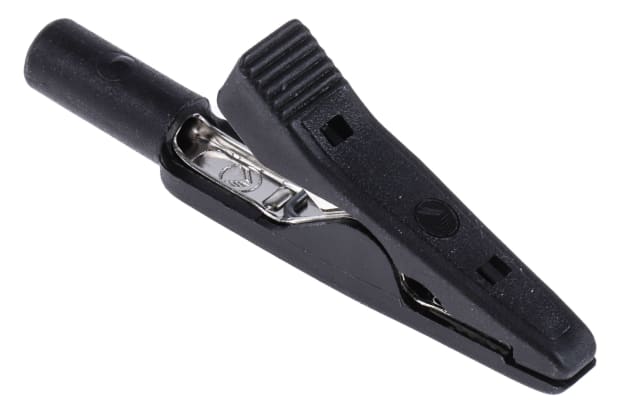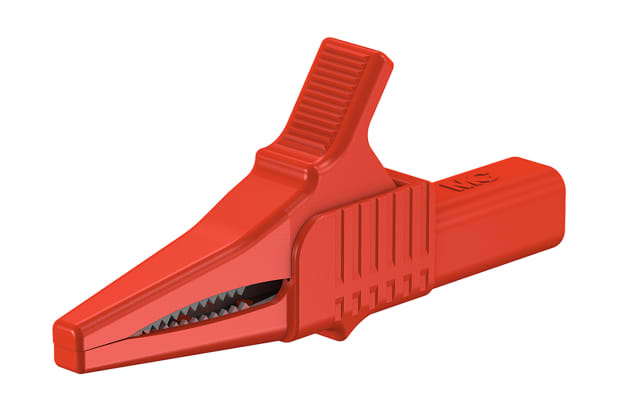- Published 7 Mar 2023
- Last Modified 29 Aug 2023
- 6 min
Crocodile Clips – A Complete Guide
What are the different types of crocodile clip? Discover their uses and the types available in our guide.

What are Crocodile Clips and What Do They Do?
Crocodile clips are spring-loaded attachments with serrated edges and small teeth. They are typically made from steel or copper and are also known as alligator clips, plier clips, and battery clamps.
Crocodile clips are principally used to create flexible, temporary or experimental electrical connections in industrial settings or laboratories. For example, this could be between two wires or between an electrical lead and the anode or cathode of a device (i.e. the entrance and exit points of an electrical current).
In addition, crocodile clips are also frequently used in education to demonstrate the function of batteries, bulbs or circuitry. Meanwhile, larger crocodile clips are often used in garages and car maintenance, where they are used with battery chargers and jump leads or for welding operations, where they can also usefully absorb excess heat.
Crocodile clips also have some non-electrical functions – for example, attaching identification badges or entry passes to clothing, assembling models before glue or solder is applied, and for holding dentistry bibs in place. They also have a multitude of additional uses, including everything from suspending models to attaching tent ropes.
How to Use Crocodile Clips
If you are using a crocodile clip purely as a clamp to hold two objects in place, operation is normally straightforward. However, using clips to create an electrical connection is more complex. Follow the guidelines below to connect wires to a battery or similar electrical device using crocodile clips, then test the connection:
- Firstly, ensure that all electrical items are disconnected from power
- Use wire strippers to remove the plastic insulation from the end of the wire. A light pinch should be sufficient to cut through the coating, allowing it to be easily peeled away
- Thread the now-exposed end of the wire through the hole at the back of the clip and then loop it around the fastening screw if one is available, before tightening to hold it in place. If there is no screw, you may need to crimp the wire to hold it in place, using a suitable crimp tool. Alternatively, there may be metal wings that can be bent into place using pliers in order to secure the wire
- Apply solder. Create a small patch of molten solder by placing the end of the heated soldering iron against a roll of the substance, then apply the molten solder to the crocodile clip and wire connection and allow this to cool. Make sure to proceed with caution as soldering creates high temperatures
- There is now a solid connection between the clip and the wire. Open the jaws by pinching the back and attach this to the battery or electrical device
- Apply a standard voltage indicator to test and ensure that the current is flowing correctly
Crocodile Clip Types
The content below outlines some of the different types of crocodile clips available and explains their typical uses.

Insulated crocodile clip
Suitable for creating electrical connections - the insulation protects users
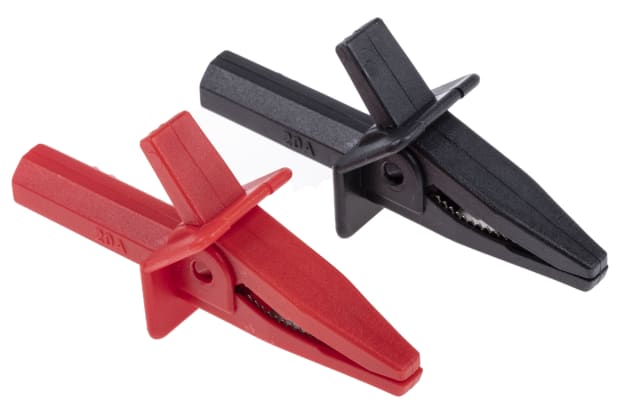
Plastic crocodile clip
Suitable for creating electrical connections - the plastic shell provides robust insulation
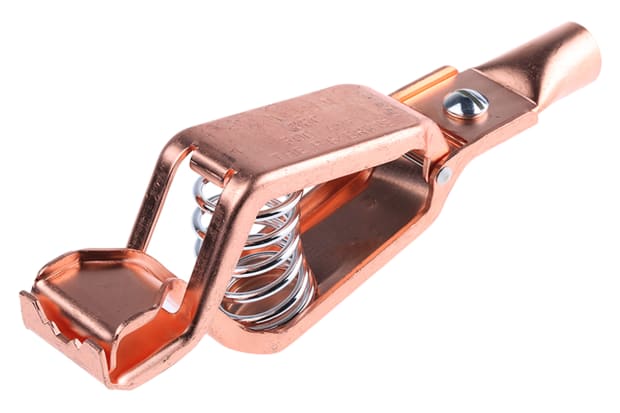
Heavy-duty crocodile clip
Suitable for tasks involving high currents or heavy industrial equipment such as power generators, battery chargers, or welding tools
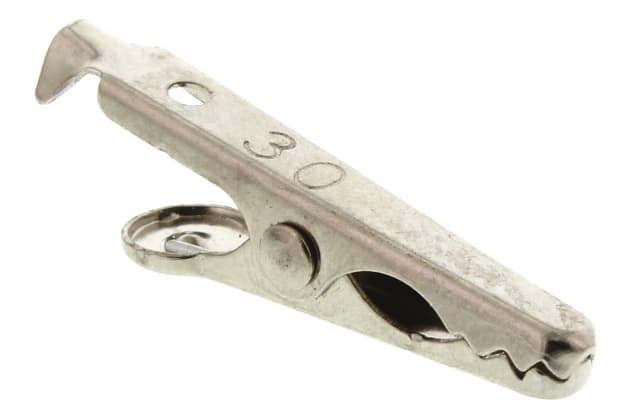
Micro crocodile clip
Suitable for a variety of precise tasks, including clipping test meters, grounding electrical equipment, and battery connections
Crocodile Clip Brands
With so many different brands to choose from, finding the ideal product for your requirements is simple when you shop with RS Components. The following is a selection of leading crocodile clip brands:
Mueller Electric
With an extensive range of products available, browse crocodile clips from Mueller Electric online with RS Components.
RS Pro
RS Pro, our own in-house brand, features a range of high-quality crocodile clips perfect for your requirements.
Hirschmann T&M
With many different sizes, colours, and current ratings available, view our full range of Hirschmann Test & Measurement crocodile clips.
Staubli
High-quality and durable, explore the full range of Staubli crocodile clips and shop online with RS Components.
Crocodile Clip Insulation Material
Different types of insulation material are used in the manufacture of crocodile clips. Some of the most common insulation materials include:
- Acetate : Acetate is a reliable, heavy-duty insulation material
- Glass Fibre Reinforced Nylon : A versatile, safe, and highly compatible insulating material
- Molded PVC : A rugged insulation option
- Nylon : Robust and affordable
- PE : Provides full insulation with good plug compatibility
- Polyamide : An ideal choice when a rigid connection is required
- PP : Polypropylene is a high-strength insulation option
- PS : Polystyrene is a widely used and adaptable insulating material
- PVC : Polyvinyl chloride is a widely used and highly versatile insulating material
- Rubber : Traditional rubber is a durable and reliable insulating material
- Silicone : Silicone is flexible, compatible, and resistant to high temperatures
- Tenite Acetate : This is a tough, resistant insulation option, making it ideal for use in handles
- TPE : Thermoplastic elastomer is a versatile, widely-used material providing good insulation
FAQs
What are Crocodile Clips Made from?
Crocodile clips can be made from different materials but the most common include copper and steel. Different varieties of steel each offer varying benefits, as outlined below:
- Stainless Steel is tough and resistant to corrosion, but it can be difficult to solder
- Nickel-Plated Steel also offers good resistance to corrosion and is widely used in industrial crocodile clips
- Gold-Plated Steel is ideal for clips which need to be highly conductive to electricity but is also more prone to wear than alternative types of steel
Meanwhile, copper is also widely used for clips which need to have a low level of electrical resistance. Crocodile clips used by mechanics for vehicle maintenance and repair are typically made from insulated copper.
What is the Difference Between Crocodile Clips and Alligator Clips?
There is no real difference between crocodile clips and alligator clips. As a general rule, the term ‘crocodile clip’ is widely used in the UK whereas ‘alligator clip’ is more widespread in the USA, but the two terms are usually used interchangeably.
